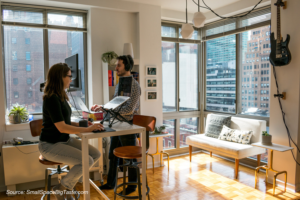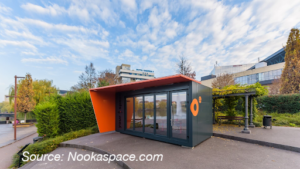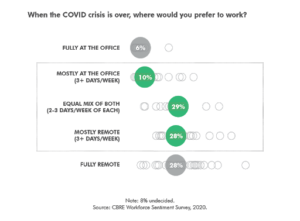The first anniversary of the COVID-19 lockdown has passed and the percentage of US citizens getting vaccinated continues to rise exponentially each day. Yet, life is far from business as usual circa early 2020. In fact, many of us still find ourselves making the short commute from kitchen sink to kitchen table each work day. What we thought was temporary might just be permanent. Working from home, some or all of the time, continues to be the norm for the majority of Americans right now. (usnews.com) Like Ford Motor Company’s recent announcement, many companies have announced keeping workers remote indefinitely or incorporating more remote working hours post-pandemic for those whose jobs can be done through telecommuting. With that in mind, it’s time to get serious and develop a long-term strategy for making Work From Home work for you.
This month we examine work space trends as we transition out of the holding pattern of the pandemic and into what we think will be a “new normal.”
INSIDE HOME SPACE
Topping the list of “must-have” items for optimal productivity in the WFH lifestyle is a dedicated work space in whatever form that takes. Whether a full room with a door or a repurposed alcove, having a place to do what you need to do on a daily basis is key. It signals “work” and helps you get in the work mindset. Over this last year, modifications had to be made to make our new work situation went from simply do-able (kitchen table!) to sustainable. (For more on this, see the Mayo Clinic’s visual guide to office ergonomics.)
Inside homes with limited space, homeowners have had to get creative. Closet offices like the one shown here are a thing. The garage, the attic and even the extra bathroom are all home office options for a house full of people trying to incorporate work and school into their private space.
For maximum comfort, many have rebuilt what worked for them in their former corporate offices. Proper office chairs and desks along with electronics have all seen a boost in sales.
For those that want the full experience, Panasonic now sells a home cubicle. Currently available only in Japan, the desk with wooden pegboard surround is more attractive than the typical standard office cube.
The hope here is that this design melds with a home’s interior setting. However, for those that really want an authentic “at work” feeling there is no doubt that the Komoru home cubicle means business.
OUTSIDE HOME SPACE
For homeowners who literally want to separate work from home the answer is a backyard office. Designing and building your own ADU (accessory dwelling unit) is one way to go but the major trend in this area is prefabricated sheds and they’re gaining momentum in 2021. Established manufacturer Studio Shed has seen a tenfold increase in sales over 2019 summer orders. Key to their appeal is customization and cost. Prefabricated ADUs are usually cheaper and definitely quicker than building a home addition.
Nooka, a start-up out of Ireland, is taking the shed model one step further and offering a lease option and a 90 day money-back guarantee on their prefabricated “smart” offices. Their subscription service even offers an option to re-rent out the units to generate income. Nooka Spaces, as they’re called, arrive assembled and fully equipped with all of the amenities a typical office would provide. Of-the-moment upgrades include energy and air quality monitoring and UV-C lights. Those and other “smart” features can all be managed from their app. Not available in the US until 2022, Nooka’s business model is part of the larger trend of alternative office space that will become increasingly important to corporations and municipalities as the pandemic subsides and employers look to accommodate remote workers.
CORPORATE OFFICE SPACE
So what’s going to happen to your former corporate office space – the one you left “temporarily” last spring? In a survey done by CBRE, only 6% of employees surveyed want to go back full-time.
As these results illustrate, the ideal office situation for post-pandemic work life could be a blend of work-from-home with work-from-somewhere else. Sometimes, but not frequently, that some-where-else would also include the corporate office. “The main office will remain important for most companies, but fewer employees will be expected to be there all day, every day.” (nytimes.com)
As the country reopens the main office will have to rethink its role. With social distancing in mind, companies will have to give workers more space through redesign, or staggered work hours. This will make continued remote working essential to safely reopening.
In addition to protecting workers safety, the corporate office will need to provide meeting space for group work and socialization – things that remote workers say they miss the most, as well as private space for deep work. From ergonomics, to atmosphere to advanced technology, a corporate office will have to provide this and more to lure and retain talent.
If there’s one word that best describes our future work spaces, it’s choice. Employers’ flexibility in responding to the pandemic needs to continue into the recovery and beyond. The corporate office will need to be an option rather than the default. Better equipped coffee shops, co-working spaces and corporate owned pods are choices that remote workers will have more access to in the near future. With 59% of remote workers saying they would choose an employer who offered remote work compared to those who didn’t, work space flexibility may prove better for all businesses.
Here’s a series of links to explore that give a window into the WFH future.
Home Office Conversion Cost By Room
Remote Work Hub Competition sponsored by Common
Here’s What Bleisure Looks Like
As always, if you or other business development leaders within your personal network would like to explore possible IMMERST office solutions, please share this content or reach out to us directly by clicking here : https://stephenswaring.com/immerst/ We’ll arrange a short consultative phone call to discuss your needs and explore partnership opportunities.


